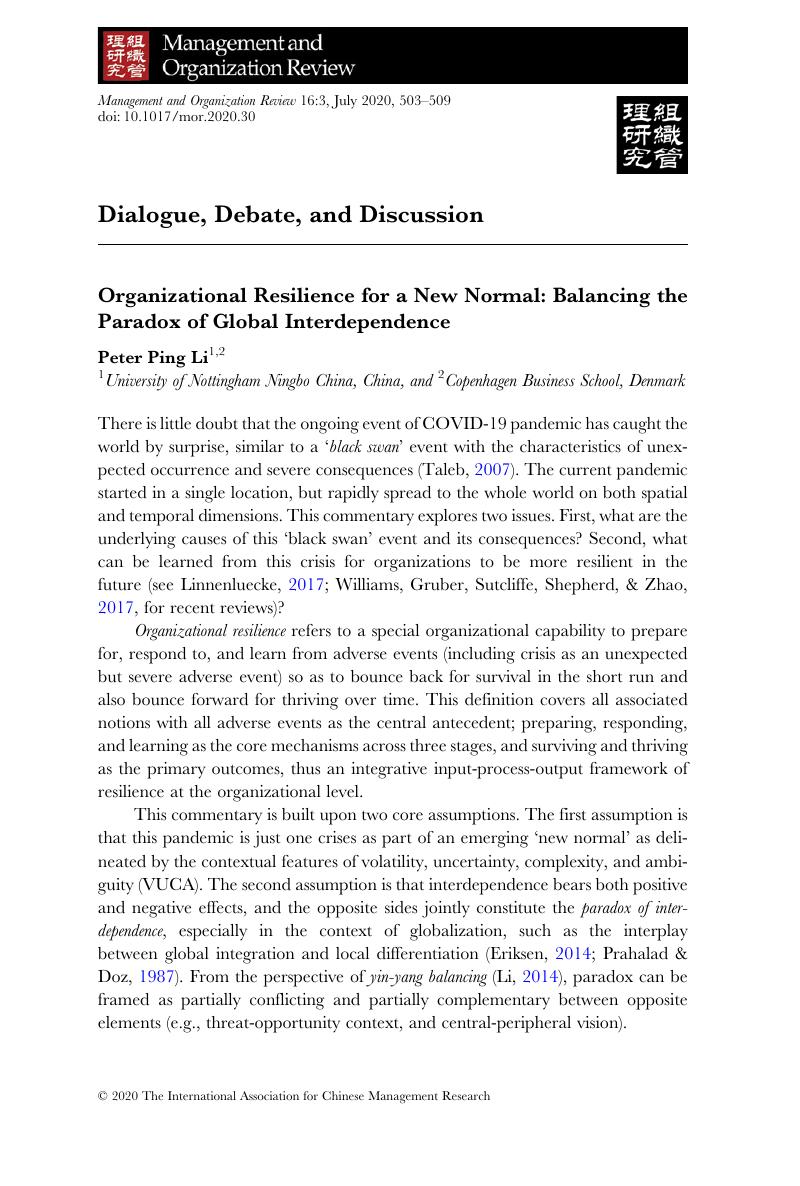Crossref Citations
This article has been cited by the following publications. This list is generated based on data provided by Crossref.
Välikangas, Liisa
and
Lewin, Arie Y.
2020.
The Lingering New Normal.
Management and Organization Review,
Vol. 16,
Issue. 3,
p.
467.
Cai, Qiurong
and
Ye, Jihong
2020.
Is China's Emergency Management System Resilient Against the COVID-19 Pandemic?.
Management and Organization Review,
Vol. 16,
Issue. 5,
p.
991.
Liu, Yuhuan
and
Yin, Juelin
2020.
Stakeholder Relationships and Organizational Resilience.
Management and Organization Review,
Vol. 16,
Issue. 5,
p.
986.
Sydow, Jörg
Helfen, Markus
and
Auschra, Carolin
2021.
Rethinking Global Production Networks in the Face of Crises: A Comment from Germany in Light of COVID-19.
Management and Organization Review,
Vol. 17,
Issue. 2,
p.
401.
Curran, Louise
and
Eckhardt, Jappe
2021.
Why COVID-19 Will Not Lead to Major Restructuring of Global Value Chains.
Management and Organization Review,
Vol. 17,
Issue. 2,
p.
407.
Yang, Hangsheng
Tang, Min
Chao, Xiangrui
and
Li, Pu
2021.
Organisational resilience in the COVID-19: A case study from China.
Journal of Management & Organization,
Vol. 27,
Issue. 6,
p.
1112.
Tallman, Stephen
2021.
Comments on ‘Multinational Enterprises and International Cartels: The Strategic Implications of De-gobalization’ by Peter J. Buckley and Mark Casson.
Management and Organization Review,
Vol. 17,
Issue. 5,
p.
989.
Li, Peter Ping
2021.
Globalization, Political Economy, Business and Society in Pandemic Times.
p.
221.
Sparr, Jennifer L.
2021.
Vom Paradox zur Resilienz in der Krise: Ein Modell für erfolgreiches Krisenmanagement.
Gruppe. Interaktion. Organisation. Zeitschrift für Angewandte Organisationspsychologie (GIO),
Vol. 52,
Issue. 4,
p.
579.
Allen, K J
Reide, F
Gouramanis, C
Keenan, B
Stoffel, M
Hu, A
and
Ionita, M
2022.
Coupled insights from the palaeoenvironmental, historical and archaeological archives to support social-ecological resilience and the sustainable development goals.
Environmental Research Letters,
Vol. 17,
Issue. 5,
p.
055011.
Cui, Lin
Gao, Qiuling
Guo, Jinyu
and
Ma, Pengcheng
2022.
OFDI performance of EMNEs: A review and recommendations for future research.
Journal of International Management,
Vol. 28,
Issue. 3,
p.
100967.
Fehrer, Julia A.
and
Bove, Liliana L.
2022.
Viewpoint: shaping resilient service ecosystems in times of crises – a trans-Tasman perspective.
Journal of Services Marketing,
Vol. 36,
Issue. 4,
p.
489.
Förster, Charlotte
and
Duchek, Stephanie
2022.
Leadership After COVID-19.
p.
17.
Förster, Charlotte
Paparella, Caroline
Duchek, Stephanie
and
Güttel, Wolfgang H.
2022.
Leading in the Paradoxical World of Crises: How Leaders Navigate Through Crises.
Schmalenbach Journal of Business Research,
Vol. 74,
Issue. 4,
p.
631.
Paeffgen, Thea
2022.
Organisational Resilience during COVID-19 Times: A Bibliometric Literature Review.
Sustainability,
Vol. 15,
Issue. 1,
p.
367.
Foroughi, Zeynab
Ebrahimi, Parvin
Aryankhesal, Aidin
Maleki, Mohammadreza
and
Yazdani, Shahram
2022.
Toward a theory-led meta-framework for implementing health system resilience analysis studies: a systematic review and critical interpretive synthesis.
BMC Public Health,
Vol. 22,
Issue. 1,
Alva, Edgar
Vivas, Vanina
and
Urcia, María
2023.
Entrepreneurial bricolage: crowdfunding for female entrepreneurs during COVID-19 pandemic.
Journal of Entrepreneurship in Emerging Economies,
Vol. 15,
Issue. 4,
p.
677.
Yang, Hangsheng
Tang, Min
and
Huang, Ju
2023.
Can Female Executives Enhance Organizational Resilience? Evidence from China during the COVID-19 Pandemic.
Sustainability,
Vol. 15,
Issue. 18,
p.
13532.
Desa, Geoff
Dunham, Ian M.
Jeong, Nara
Basu, Sandip
and
Kleinrichert, Denise
2023.
Culture Matters: Antecedent Effects of Societal Culture on the Resource Mobilisation Strategies of Social Ventures.
Journal of Social Entrepreneurship,
p.
1.
Vladi, Ornela
2023.
Responding to Uncertain Conditions: New Research on Strategic Adaptation.
p.
199.


